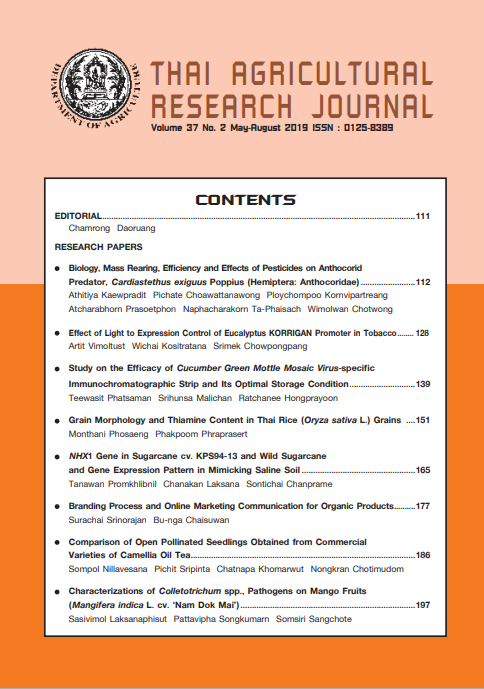Biology, Mass Rearing, Efficiency and Effects of Pesticides on Anthocorid Predator, Cardiastethus exiguus Poppius (Hemiptera: Anthocoridae)
DOI:
https://doi.org/10.14456/thaidoa-agres.2019.9Keywords:
Cardiastethus exiguus, mass rearing, efficiency, side - effectsAbstract
Cardiastethus exiguus Poppius (Hemiptera: Anthocoridae) is a beneficial anthocorid predator. It was first ecorded in Thailand in 2013 but very little information is available This research, aims at studying the life cycle and biological attributes, effect of food resources, egg-laying substrates and temperature suitable for mass rearing, including predatorial efficiency to control insect and mite pests and effects of some pesticides on C. exiguus. The experiments were carried out from October 2013 - September 2018 at Plant Protection Research and Development Office, Department of Agriculture. The Biology of this predator was studied using rice moth egg (Corcyra cephalonica) as food. The results revealed that exiguus had three stages with the average egg, nymphal, and adult periods of 4.18, 17.72,and 49.13 days, respectively. It grew better when fed with rice moth eggs as indicated by the net reproductive rate of increase (Ro) which was 11.88 compared to 0.790 when reared with cattail pollens. The most suitable egg laying material was paper towel with the highest number of eggs laid at 130 eggs per life expectancy. Paper towel also yielded the highest number of egg hatching at 91.47% which was significantly higher (P <0.05) than other materials. The optimum temperature for mass rearing was 27± 1ºoC of which the average of 114 eggs with 89.68% hatching were obtained from individual bug. The biological life tables were examined by feeding on four pest species, namely Thrips palmi, Phenacoccus manihoti, Tetranychus truncatus and Polyphagotarsonemus latus. The net reproductive rate (Ro) when feeding on these preys was 5.89, 5.60, 2.9 3 and 0.0, respectively. The female adult could feed up to 348.52 T. palmi in its life cycle. Under greenhouse conditions, adult female consumed 15.50 T. palmi per day while the 3rd nymphal stage it consumed 15.32 per day. Eight of 14 insecticides i.e. amitraz, pyridaben, spinetoram, white oil, metalaxyl, mancozeb, carbendazim and sulfur showed no effect on C. exiguus when treated by dry-film method for 7 days, In conclusion C. exiguus is a promising predator that can easily be mass reared at low cost and effectively used to control T. palmi in greenhouse condition.
References
อทิติยา แก้วประดิษฐ์ พิเชฐ เชาวน์วัฒนวงศ์ พลอยชมพู กรวิภาสเรือง อัจฉราภรณ์ ประเสริฐผล และรจนา ไวยเจริญ. 2557. การศึกษาชีววิทยาและความชอบของมวนตัวห้ำ Cardiastethus exiguus Poppius (Hemiptera: Anthocoridae) ที่มีต่อเหยื่อ.หน้า 31 - 43. ใน การประชุมสัมมนาวิชาการอารักขาพืช. สำนักวิจัยพัฒนาการอารักขาพืช กรมวิชาการเกษตร 3 - 5 กันยายน 2557. ณ เดอะ กรีนเนอรี่ รีสอร์ท, นครราชสีมา.
อินทวัฒน์ บุรีคำ. 2548. นิเวศวิทยาวิเคราะห์ทางกีฏวิทยา. ภาควิชากีฏวิทยา คณะเกษตร
มหาวิทยาลัยเกษตรศาสตร์ นครปฐม. 180 หน้า
อินทวัฒน์ บุรีคำ และ บรรพต ณ ป้อมเพชร. 2521. คุณลักษณะทางชีววิทยาของมวนตัวห้ำ
Cantheconidea furcellata (Wolff) (Hemiptera: Pentatomidae). เอกสารวิชาการ
ฉบับที่ 4. ศูนย์วิจัยควบคุมศัตรูพืชโดยชีวินทรีย์แห่งชาติ มหาวิทยาลัยเกษตรศาสตร์
กรุงเทพฯ. 13 หน้า. (อัดสำเนา)
Ballal, R.C., S.P. Singh, J. Poorani and T. Gupta. 2002. Feasibility of mass multiplication and utilization of Cardiastethus exiguus Poppius, a potential anthocorid predator of Opisina arenosella Walker (Lepidoptera: Oecophoridae). Biological Control: 29 - 33.
Beneficial Insectary Inc.2018. ORIUSforce™ for Thrips control. (Online). Available. https://greenmethods.com/orius/ (December 25, 2018)
Biddinger D. J. and L. A. Hull.1995. Effects of Several Types of Insecticides on the Mite Predator, Stethorus punctum (Coleoptera: Coccinellidae), Including Insect Growth Regulators and Abamectin. Economic Entomology. 88(2): 358-366 p .Borror, D.J., C.A. triplehorn and N.F. Johnson. 1989. An Introduction to the Study of Insect. 6th ed. Saunders College Publishing, USA. 875 p.
Biologicalservices. 2018. Orius Orius tantillus. (Online). Available. https://www.biologicalservices.com.au/products/orius-29.html, 25 December 2018
Cocuzza, G. E., P. De Clercq, M. Van de Veire, A. De Cock, D. Degheele and V. Vacante.
1997. Reproduction of Orius laevigatus and Orius albidipennis on Pollen and
Ephestia kuehniella Eggs. Entomologia Experimentalis et Applicata 82: 101-104.
Gnanadhas P., Johnson S., Thiagarajan M. Subramanian C and Sasthakutty K.. 2008. Toxicity of imidacloprid and diafenthiuron to Chrysoperla carnea (STEPHENS) (Neuroptera: Chrysopidae) in the laboratory conditions. Journal of plant protection research 49: 3 290-296.
Gomez, K.A. and A.A. Gomez. 1984. Statistical Procedures for Agricultural Research. John Wiley & Sons, New York.
Loughlin, R. 1965. Capacity for increase: a useful population statistics. Journal of
Animal Ecology 34: 77-91.
Maneerat, T. 2007. Potential of Anthocorid Bug, Wollastoniella rotunda Yasunaga & Miyamoto (Hemiptera: Anthocoridae) for Biological Control of Thrips palmi Karny (Thysanoptera: Thripidae). M.S. Thesis. Kasetsart University, Bangkok. 88 p.
Nagai, K. and E. Yano. 1999. Effects of Temperature on the Development and Reproduction of Orius sauteri (Poppius) (Heteroptera : Anthocoridae), a Predator of Thrips palmi Karny (Thysanoptera: Thripidae). Applied Entomology and Zoology 34: 223-229.
Napompeth, B. 1973. Ecology and Population Dynamics of the Corn Planthopper, Peregrinus maidis (Ashmead) (Homoptera: Delphacidae), in Hawaii: Ph.D. Dissertation. University of Hawaii. 257 p.
Price, P.W. 1997. Insect Ecology. John Wiley & Sons. Inc, USA. 607 p.
Ratanaka, S. 2003. Biological Study of Wollastoniella rotunda Yasunaga & Miyamoto (Hemiptera: Anthocoridae) and Its Role as Biological Control Agent of Thrips palmi Karny (Thysanoptera: Thripidae). M.S. Thesis, Kasetsart University.
Veire and Degheele. 1996. Laboratory test method to evaluate the effect of 31 pesticides on the predatory bug, Orius laevigatus (Het: Anthocoridae) 41: 235–243.
Wilson, E.O. and W.H. Bossert. 1971. A Primer of Population Biology. Sinauer Associates, Inc. Publishers, Stamford, Connecticut. 192 p.
Yano, E., K. Watanabe and K. Yara. 2002. Life History Parameters of Orius sauteri (Poppius) (Het., Anthocoridae) Reared on Ephestia kuehniella Eggs and the Minimum Amount of the Diet for Rearing Individuals. Journal of Applied Entomology 126: 389-394.
Downloads
Published
How to Cite
Issue
Section
License
Copyright (c) 2019 Thai Agricultural Research Journal

This work is licensed under a Creative Commons Attribution-NonCommercial-NoDerivatives 4.0 International License.
Thai Agricultural Research Journal



